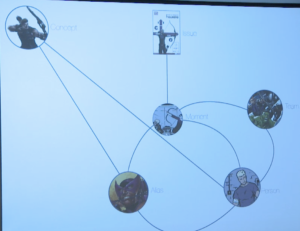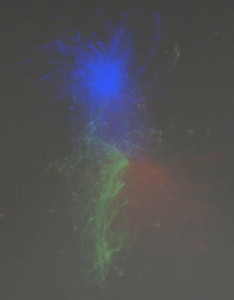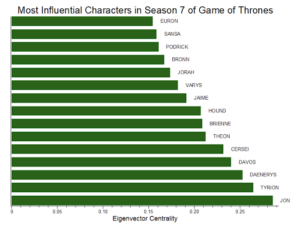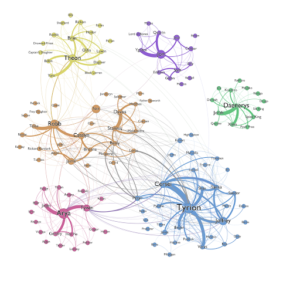Motivation
Constructing a fictional universe is an immense challenge with a multitude of factors that must be taken into consideration. Oftentimes, it takes teams of people to effectively balance creating a coherent universe that adheres to its timeline while also developing unique and interesting individual stories or characters. Many times, when these fictional universes grow too large and ambitious, they begin to lose a sense of direction and become a mess of interconnected stories riddled with plot holes. A clever approach to solving this may exist in the use of graph theory.
Analysis
Firstly, graph theory can have excellent applications in showing the interconnectedness of various characters and stories. Characters such as Hawkeye may appear in certain issues of a comic but under different aliases. Marvel identifies these different comic book issues and represents them as nodes in a graph and connects them to a single hawkeye node to better manage this data. Similarly, there may be a variety of comic book issues that all take place at different times but share interconnected events that impact each other. Marvel noticed this and also devised graphs for many of their most popular events and generated graphs to get a better sense of their
 timeline and how each comic book may influence another one. This strategy of using graphs can be extremely helpful in visualizing complex timelines and synthesizing multiple pieces of data into a simple node. This data can then be further analyzed by merging the many different graphs of stories or characters together to get a better sense of the amount of content in a certain “phase” of comics or the representation of various characters. We can see from this corresponding graph of the marvel universe,
timeline and how each comic book may influence another one. This strategy of using graphs can be extremely helpful in visualizing complex timelines and synthesizing multiple pieces of data into a simple node. This data can then be further analyzed by merging the many different graphs of stories or characters together to get a better sense of the amount of content in a certain “phase” of comics or the representation of various characters. We can see from this corresponding graph of the marvel universe,
 that it is similar to graphs shown in class. We can see large groupings of content together indicating phases/story arcs of content. We can notice that it only takes one connection between two phases to connect all of the stories in one phase to all of the stories in another phase. To learn more about Marvel’s use of graph theory, there is an excellent video cited below entitled “Marvel Entertainment’s Peter Olson talk about how Marvel uses graph theory and the emerging NoSQL space to understand, model and ultimately represent the uncanny Marvel Universe.”
that it is similar to graphs shown in class. We can see large groupings of content together indicating phases/story arcs of content. We can notice that it only takes one connection between two phases to connect all of the stories in one phase to all of the stories in another phase. To learn more about Marvel’s use of graph theory, there is an excellent video cited below entitled “Marvel Entertainment’s Peter Olson talk about how Marvel uses graph theory and the emerging NoSQL space to understand, model and ultimately represent the uncanny Marvel Universe.”
Moreover, an interesting application is not only using graphs to sort information and develop timelines, but to further dive into what these relationships can tell us. For example, some fans of Game of Thrones created data sets and graphs to learn more about the multitude of characters in the fictional universe. There were many interesting findings from their results, such as their ability to calculate the most influential characters to the story in the various seasons of the show through the use of eigenvector centrality.


Additionally, they created graphs for the many seasons to help visualize who were the most central characters to the plot and what characters they have interactions with. Graph theory techniques such as this can reveal many interesting pieces of information that can help lead to creating better stories. For example, an author may realize that a character that they originally intended on being a side character has a growing influence and impact on a story. This can be helpful to know because an author may want to use this information to either cut down on the involvement of this character or to delve deeper into their backstory to make a more enriching character arc around this now pivotal figure. It can also be helpful in generating creative new ideas by noticing that certain groups are unintentionally rarely in contact with each other and perhaps should have more collaboration. Inversely, it may indicate that the author has continued to be effective in keeping plot lines isolated from each other so that they can merge at a later date without having to worry about plot holes from previous interactions.
Conclusion
Overall, harnessing the power of graph theory can be a tremendous asset to an author or a team of writers in managing their complex fictional universes. Some of the most successful creators of these universes, such as Marvel, have already been using these techniques to analyze and manage their ongoing stories to help deliver the most cohesive and entertaining stories to their audience. Graph theory has many profound uses in the world of fiction and I believe that it is a necessity to take advantage of as fictional universes become evermore expansive.
Sources
Marvel Entertainment’s Peter Olson talk about how Marvel uses graph theory and the emerging NoSQL space to understand, model and ultimately represent the uncanny marvel universe. – from taming galactus: How marvel uses graph theory and nosql to understand its fictional universe. Livestream. (n.d.). Retrieved October 1, 2022, from https://livestream.com/hugeinc/events/2474611/videos/32324838
Character interaction network. MaplePrimes. (n.d.). Retrieved October 1, 2022, from https://www.mapleprimes.com/maplesoftblog/210356-Game-Of-Thrones-And-Graph-Theory
Networkofthrones, /. (2020, January 14). Network of thrones. Network of Thrones. Retrieved October 1, 2022, from https://networkofthrones.wordpress.com/